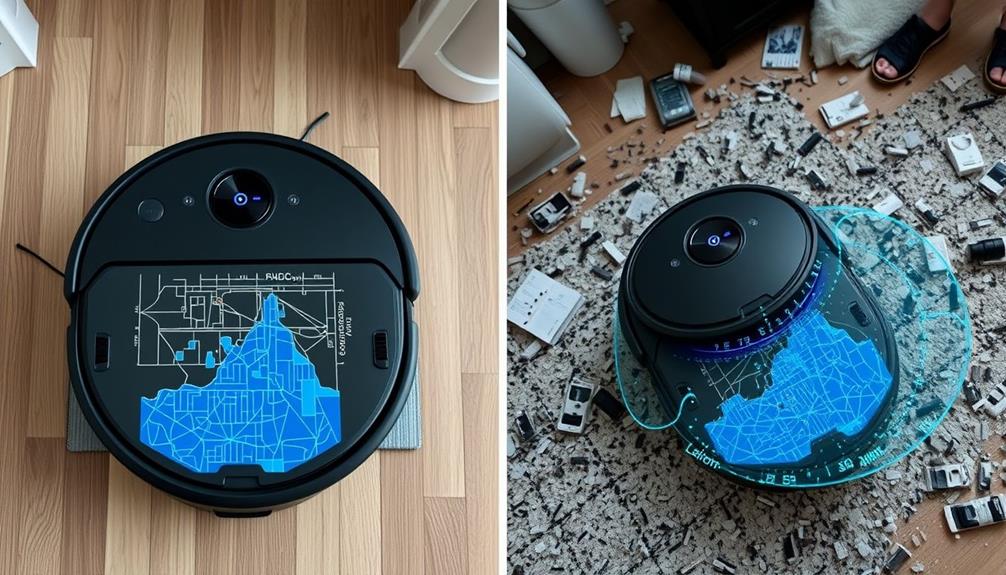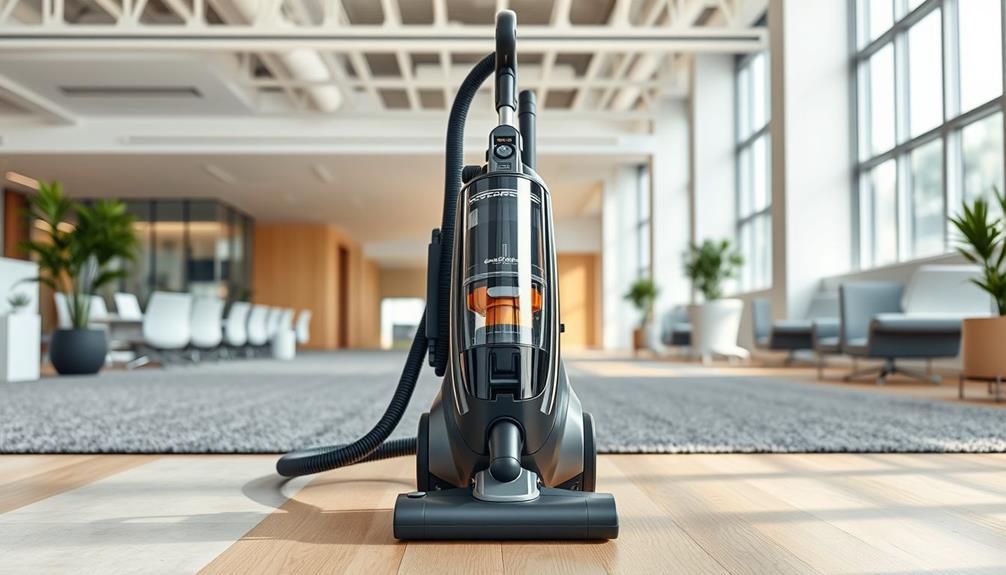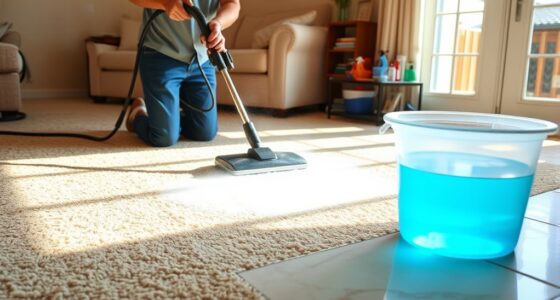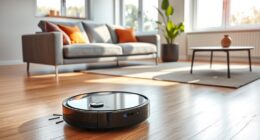When it comes to pool maintenance, both manual and automatic skimmers have their own advantages. Manual skimmers are cost-effective and provide precise control for smaller pools, making them ideal for quick cleanups. However, they require daily attention. On the other hand, automatic skimmers save you time and reduce the need for maintenance with their efficient, autonomous operation, particularly suitable for larger or heavily landscaped areas. While automatic skimmers may have a higher initial cost, they could ultimately save you money on long-term maintenance. Your choice between these options will depend on the size of your pool and how much time you are willing to dedicate to upkeep. There are also other factors to consider!
Key Takeaways
- Manual skimmers are cost-effective, ranging from $20-$50, while automatic skimmers start at $100, catering to different budget levels.
- Manual skimmers provide hands-on control for targeted cleaning, while automatic skimmers operate independently for convenience.
- Automatic skimmers require less maintenance, needing only weekly skimmer basket cleaning compared to daily use for manual skimmers.
- Automatic models enhance efficiency with advanced sensors, adapting to varying debris levels, unlike the straightforward operation of manual skimmers.
- Choosing between manual and automatic skimmers impacts both time spent on maintenance and long-term cost efficiency for pool care.
Importance of Pool Skimmers
When it comes to pool maintenance, skimmers play an indispensable role. They're your first line of defense against debris, effectively removing leaves, insects, and contaminants from the water's surface. By using pool skimmers regularly, you'll find it much easier to maintain a clean and inviting swimming environment.
Not only do they enhance water circulation, but they also help distribute chemicals evenly, which is essential for ideal water quality. Additionally, incorporating skimmers into your overall pool design choices can improve efficiency and aesthetics, as consider landscaping and surrounding features can complement the functionality of your skimmers.
A well-functioning skimmer directs floating debris toward your filtration system, improving its efficiency and reducing the strain on it. This means less time spent on manual cleaning, giving you more time to enjoy your pool.
Additionally, skimming prevents the growth of algae and bacteria, creating a safer environment for swimming and minimizing the need for costly chemical treatments.
Incorporating skimmers into your pool maintenance routine can save you time and money while ensuring your pool remains beautiful and healthy. So, if you want to enjoy crystal-clear waters without the hassle, investing in effective pool skimmers is a smart choice.
Types of Pool Skimmers

Understanding the various types of pool skimmers can greatly enhance your pool maintenance experience. Choosing the right skimmer will depend on your pool size, debris type, and how much time you want to spend cleaning. Here's a quick overview of the main types of skimmers available:
| Type | Description | Best For |
|---|---|---|
| Manual Skimmers | Handheld devices for collecting debris | Light debris and small pools |
| Automatic Skimmers | Connects to the pool's filtration system | Busy pool owners |
| Robotic Skimmers | Autonomous devices with sensors | Advanced cleaning needs |
| Inground Skimmers | Built into the pool structure | Seamless integration |
| Above-Ground Skimmers | Attach to walls or float on the surface | Above-ground pools |
Manual skimmers are great for targeted cleaning, but they require more effort, especially in larger areas. On the other hand, automatic skimmers take care of the job for you, making them appealing for those with a hectic lifestyle. No matter which type of skimmer you choose, understanding the options available to you can lead to a cleaner, more enjoyable pool experience.
Manual Skimmers Overview

Manual skimmers are essential tools for maintaining a clean pool surface, especially for those who enjoy a hands-on approach to upkeep. These handheld devices consist of a long pole with a net attached at the end, allowing you to efficiently scoop out leaves, insects, and other floating debris.
Because they don't rely on electricity or complex mechanisms, manual skimmers are cost-effective and straightforward to use. Additionally, using a manual skimmer complements pool maintenance solutions by providing immediate results in keeping your pool clear and inviting.
Ideal for smaller pools, manual skimmers give you precise control over collecting debris, making them perfect for regular maintenance. By skimming the pool surface every few days, you can notably reduce the amount of debris that accumulates, which helps prevent clogging in the pool's filtration system.
This not only enhances water clarity but also minimizes the time you'll need for more extensive cleaning tasks.
Using a manual skimmer can be a rewarding experience, as it keeps your pool looking pristine while allowing you to stay actively involved in your pool's upkeep.
Plus, the satisfaction of seeing immediate results from your efforts can make regular maintenance feel less of a chore and more of a invigorating activity in your pool care routine.
Automatic Skimmers Overview

Automatic skimmers offer a convenient way to keep your pool clean without the hassle of manual labor.
These devices not only save time but also guarantee a more thorough cleaning experience, similar to what you'd expect from a professional service what to expect from a home cleaning service.
With features like programmable settings and built-in pumps, they efficiently collect debris, making them ideal for larger pools or those surrounded by heavy foliage.
Let's explore the benefits and key features that set automatic skimmers apart from traditional options.
Benefits of Automatic Skimmers
Many pool owners find that automatic skimmers offer a hassle-free solution for maintaining clean water.
These devices connect directly to your pool's filtration system, allowing for continuous debris collection without any manual effort on your part.
Just like toilet flushing practices that can impact plumbing systems, keeping your pool clean with effective skimming is essential for ideal water quality.
Here are three compelling benefits you'll enjoy with automatic pool skimmers:
- Time Savings: With sensors guiding the pool surface, these skimmers adapt to different debris types and shapes, ensuring a thorough clean while you relax.
- Low Maintenance: You'll only need to clean the skimmer basket regularly, which greatly cuts down on the time you spend on pool upkeep compared to manual skimming.
- Cost Efficiency: Investing in an automatic skimmer can lead to long-term savings by minimizing the need for chemical treatments and repairs from clogged filtration systems.
Key Features Comparison
When it comes to choosing an automatic skimmer for your pool, understanding the key features can make all the difference. Automatic skimmers operate independently, using suction to collect surface debris without your intervention. This is a huge plus for busy pool owners.
Here's a quick comparison of key features:
| Feature | Automatic Skimmers |
|---|---|
| Operation | Autonomous, no manual effort needed |
| Navigation | Built-in sensors for obstacle avoidance |
| Maintenance Frequency | Less frequent, often on timers |
Additionally, many automatic skimmers connect directly to your pool's existing filtration system, ensuring effective debris removal. You'll appreciate how they typically require less maintenance than manual skimmers, freeing you up for other activities. Some advanced models even incorporate solar power or smart connectivity, enhancing energy efficiency and offering user convenience.
Comparing Skimming Methods

When choosing a skimming method, you'll want to weigh the advantages of manual skimmers against the benefits of automatic options.
Manual skimmers give you hands-on control and are budget-friendly, while automatic skimmers save you time with their independent operation.
For instance, using a manual skimmer can be quite effective for smaller pools or when addressing specific debris, making it a popular choice among pool owners for its reliability.
On the other hand, automatic skimmers enhance pool maintenance and reduce manual cleaning time considerably, similar to the benefits seen with top robotic pool vacuums.
Understanding the costs and maintenance involved with each type will help you make the best choice for your pool.
Manual Skimmer Advantages
A manual skimmer offers several distinct advantages that make it a valuable tool for pool maintenance. First and foremost, you can easily target specific areas to remove debris, guaranteeing a thorough clean. This hands-on approach allows for immediate inspection of water quality and debris types, which helps you tackle potential issues before they escalate.
Just as in maintaining a healthy environment for pets, actively engaging in your pool's upkeep can prevent larger problems down the line, such as cat health and dietary considerations.
Consider these benefits of manual skimmers:
- Cost-Effective: They don't require any electricity or complex setup, making them affordable and easy to maintain.
- Precision Control: You have the ability to effectively remove larger debris like leaves and twigs, something automatic skimmers might miss.
- Filter Longevity: Regular use of manual skimmers can greatly reduce the load on your pool filters, extending their lifespan and lowering maintenance costs.
Incorporating manual skimmers into your pool maintenance routine not only enhances cleanliness but also empowers you to actively engage with your pool's health.
Automatic Skimmer Benefits
How can automatic skimmers revolutionize your pool maintenance routine? If you're a busy pool owner, an automatic skimmer is a game-changer.
These devices operate independently, requiring minimal manual effort, making them perfect for those who want low-maintenance solutions. You can enjoy a cleaner pool without dedicating your weekends to skimming debris.
Similar to how ozone air purifiers eliminate allergens effortlessly, automatic skimmers consistently collect debris, enhancing your pool's clarity while minimizing your workload.
Automatic skimmers continuously collect debris, improving overall water clarity and greatly reducing the frequency of manual cleaning sessions.
Many models come with advanced sensors that navigate your pool efficiently, adapting to varying debris levels and environmental conditions. This means your skimmer can handle whatever nature throws at it.
Cost and Maintenance Comparison
Automatic skimmers offer convenience and efficiency, but understanding their costs and maintenance needs compared to manual skimmers is key for informed decision-making.
Here's a breakdown to help you weigh your options:
1. Initial Investment: Manual skimmers are budget-friendly, costing between $15 and $50, while automatic skimmers can start at $100 and soar above $1,000, impacting your cost efficiency.
2. Maintenance Frequency: You'll need to use manual skimmers daily or several times a week, leading to a more hands-on approach.
In contrast, automatic skimmers require maintenance just weekly or bi-weekly, giving you more free time.
3. Overall Expense: While automatic skimmers may seem pricier upfront, their consistent performance can save you money on long-term maintenance and chemical costs, making them potentially more cost-effective over time.
When choosing between these options, consider your willingness to invest in convenience versus the hands-on approach of manual skimming.
Your choice will ultimately impact both your wallet and the time you spend maintaining your pool.
Maintenance Requirements

When choosing between manual and automatic pool skimmers, understanding their maintenance requirements is vital for keeping your pool clean and clear.
Manual skimmers require frequent user intervention, typically needing to be emptied and cleaned every few days, especially during peak debris seasons. You'll need to regularly clean the net to prevent clogging and guarantee effective debris collection.
Additionally, incorporating window treatments can enhance your outdoor space's aesthetics while you maintain your pool.
On the other hand, automatic skimmers demand less ongoing maintenance. They operate independently and only require you to periodically clean the skimmer basket, which should be emptied at least weekly to prevent overflow.
Additionally, you'll want to inspect the weir door for functionality and check the suction lines for blockages.
While automatic skimmers are generally more durable, they may still require occasional adjustments to their settings or sensors.
Both types benefit from routine checks on their components, but manual skimmers are more prone to wear and tear due to physical handling.
Cost Considerations

When choosing a pool skimmer, you'll need to weigh the initial purchase price against long-term maintenance costs.
Manual skimmers are budget-friendly upfront but might require more of your time, while automatic options come with a steeper price tag but can save you effort and energy in the long run.
Additionally, considering the potential for wealth preservation across generations could influence your investment in pool maintenance tools.
Understanding these cost considerations will help you make the best decision for your pool maintenance needs.
Initial Purchase Price
The initial purchase price of pool skimmers can significantly impact your decision-making process as a pool owner. When weighing your options, consider how much you're willing to invest upfront.
Manual skimmers offer a budget-friendly choice, typically ranging from $20 to $50. However, automatic skimmers can set you back anywhere from $100 to over $1,000, depending on their features. Many pool owners also look for ways to save money on maintenance, similar to how users find discounts with best apps for finding deals.
Here are three key points to think about:
- Budget Constraints: If you're on a tight budget, manual skimmers are your go-to option.
- Time vs. Money: While automatic skimmers require a larger initial investment, they save you valuable time and effort.
- Long-term Value: Investing in an automatic skimmer may seem steep, but it could enhance your pool maintenance efficiency and save you money in the long run.
Ultimately, your choice between manual and automatic skimmers will hinge on your budget and how much you value convenience.
If you want to prioritize ease of use, an automatic skimmer might be worth the splurge, while manual skimmers can keep costs down for the more hands-on owner.
Long-term Maintenance Costs
Choosing between manual and automatic pool skimmers isn't just about the initial price; it's also about considering long-term maintenance costs. While manual skimmers usually have lower upfront costs, they demand more frequent labor and upkeep. This can lead to higher long-term costs due to the time and effort you'll need to invest.
On the other hand, automatic skimmers come with a heftier price tag, but they operate independently, greatly reducing your labor costs and freeing up your time. With a longer lifespan and often included warranties, automatic skimmers can provide better long-term value by minimizing replacement expenses.
In contrast, manual skimmers wear out faster, resulting in more frequent replacements, which can add to your overall costs.
Moreover, many automatic skimmers are designed for durability and efficiency, which can help offset their initial expense. While you may need to factor in potential energy costs with automatic models, the savings from reduced labor and replacement needs often outweigh these costs.
Ultimately, evaluating the long-term maintenance costs will help you make a more informed decision that suits your pool care needs.
Energy Consumption Differences
Understanding energy consumption differences is vital when evaluating pool skimmers, as it directly impacts your overall costs. Manual skimmers operate without electricity, resulting in zero energy costs. In contrast, automatic skimmers typically consume between 100 to 500 watts per hour, leading to monthly electricity expenses that can range from $5 to $15, depending on usage and local rates.
Here are some key points to take into account:
- Zero Energy Costs: Manual skimmers won't add to your electricity bill.
- Variable Costs: Automatic skimmers can increase your expenses, especially if used frequently.
- Long-term Savings: Investing in energy-efficient automatic skimmers can reduce costs over time.
While automatic skimmers may have higher energy consumption, they can lower labor costs since they automate cleaning. Regular maintenance of these skimmers also enhances their efficiency.
On the other hand, neglecting manual skimmers can lead to more frequent cleanings, indirectly increasing your overall energy usage.
Ultimately, weighing the initial investment against energy consumption and potential savings is important when choosing between manual and automatic skimmers for your pool.
Choosing the Right Skimmer

When selecting the right skimmer for your pool, it's essential to take into account factors like size, type, and local debris.
If you have a larger, inground pool, automatic skimmers might be your best bet for hassle-free maintenance. For smaller or above-ground pools, manual skimmers can deliver precise cleaning, though they require more hands-on effort.
Consider your maintenance preferences too. If you want convenience, an automatic skimmer can save you time, while manual skimmers let you target specific areas more effectively.
The environment around your pool also matters; if there are many trees nearby, an automatic skimmer with a larger capacity will handle heavy leaf fall more efficiently.
Don't forget to evaluate the materials and durability of the skimmer. Look for options made from stainless steel or high-quality ABS plastic to guarantee long-lasting performance.
Effectiveness and Efficiency

The type of skimmer you choose directly impacts how effectively and efficiently you can maintain your pool. If you're wrestling with debris and struggling to keep your pool crystal clear, it's time to evaluate your options.
- Time Savings: Automatic skimmers run independently, freeing up your time for relaxation instead of constant upkeep.
- Consistent Performance: With automatic skimmers, you get consistent cleaning, ensuring every corner of your pool stays spotless.
- Lower Maintenance Costs: Investing in automatic skimmers often leads to reduced wear on your filtration system, saving you money in the long run.
Manual skimmers can effectively remove large debris, but they require consistent user involvement, making them less efficient, especially for larger pools or areas with heavy debris.
You risk missing smaller particles that automatic skimmers can easily capture due to their advanced filtration options. Your efficiency with manual skimmers heavily depends on your diligence, while automatic skimmers can operate continuously, delivering optimal water clarity without your constant attention.
Choosing the right skimmer can make all the difference in maintaining your pool's cleanliness and your sanity.
User Experience and Preferences

For many pool owners, choosing between manual and automatic skimmers often hinges on personal preferences and lifestyle. Some pool owners prefer the hands-on approach of using a manual skimmer, finding it to be more effective and satisfying. Others may opt for an automatic skimmer for the convenience it offers, allowing them to save time and effort. When it comes to selecting the best vacuums for pet hair, it’s important to consider factors such as suction power, filter type, and specialized attachments for removing pet hair from different surfaces.
If you enjoy being hands-on, manual skimmers might be your go-to option. They require active participation, allowing you to feel a sense of accomplishment as you remove debris. User feedback often indicates that manual skimmers provide better control over cleaning, especially when dealing with a variety of debris types.
On the flip side, if you lead a busy life, automatic skimmers offer a convenient low-maintenance solution. They operate independently and can be scheduled to clean your pool without daily intervention. Many users appreciate the efficiency of these automatic options, as they guarantee consistent cleaning.
However, some feedback points out that automatic skimmers might miss larger or heavier debris, which could be a concern for some owners.
Ultimately, your satisfaction will depend on what you prioritize. If thoroughness and control matter most, manual skimmers may be the right choice. If ease and automation are your top priorities, an automatic skimmer could better fit your lifestyle.
Understanding your preferences will help you make the best decision for your pool maintenance needs.
Frequently Asked Questions
Do Automatic Pool Skimmers Work?
Yes, automatic pool skimmers work effectively. They use suction generated by your pool's filtration system to collect surface debris without you needing to lift a finger.
These skimmers navigate your pool's surface using built-in sensors, ensuring thorough cleaning. You can even program them to operate on specific schedules, so you won't have to worry about maintenance regularly.
With minimal upkeep, like checking the skimmer basket, you'll enjoy cleaner water with less effort.
How Do I Choose a Pool Skimmer?
Choosing a pool skimmer involves evaluating your pool type and debris load.
First, consider whether you want hands-on control or convenience. Next, analyze the local environment; heavier foliage may require a more robust skimmer.
Look for durable materials, compatibility with your filtration system, and features like reinforced frames.
Finally, check product reviews to verify your choice fits your maintenance needs and budget.
This way, you'll keep your pool clean and inviting with minimal effort.
What Is the Best Way to Skim a Pool?
To skim your pool effectively, use a slow, sweeping motion with a manual skimmer.
Focus on high-traffic areas and around ladders, where debris collects quickly. Skim daily or after storms to prevent debris from sinking.
Remember to clean the skimmer basket after each session to maintain peak suction.
If you use an automatic skimmer, set it to run daily for consistent results, keeping your pool sparkling clean with minimal effort.
How Do I Know What Type of Skimmer Basket I Need?
Choosing the right skimmer basket is like finding the perfect key for a lock; it's essential for your pool's efficiency.
Start by measuring your existing skimmer to guarantee compatibility.
Think about the material—plastic is budget-friendly, while metal offers durability.
Consider the debris type in your pool too; a finer mesh might be necessary for small particles.
Conclusion
To sum up, whether you choose a manual or automatic pool skimmer, both options have their perks. You might worry about the cost of an automatic skimmer, but consider the time and effort it saves you in the long run. You'll spend less time skimming and more time enjoying your pool. Ultimately, it comes down to your preferences and needs. Whichever you pick, keeping your pool clean and inviting is what matters most!









